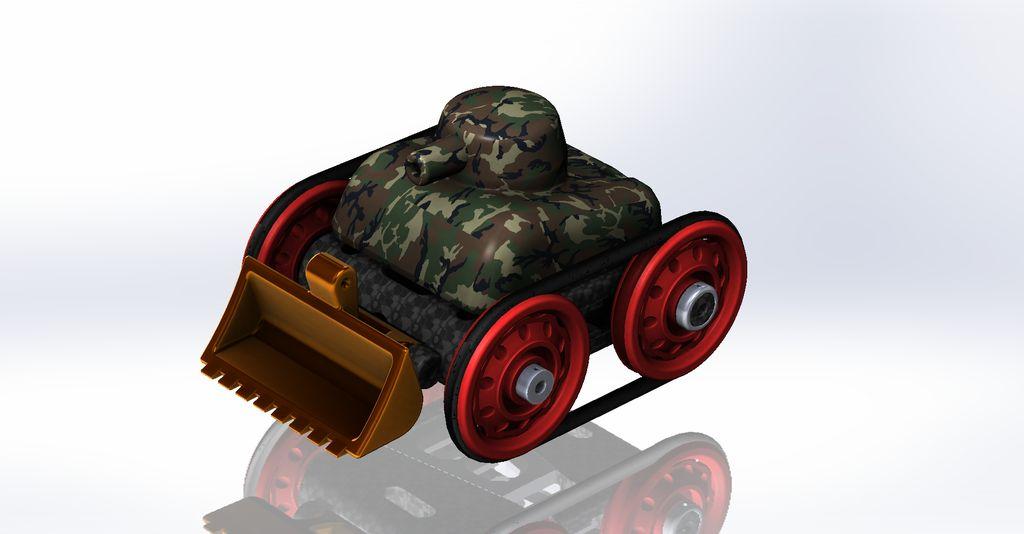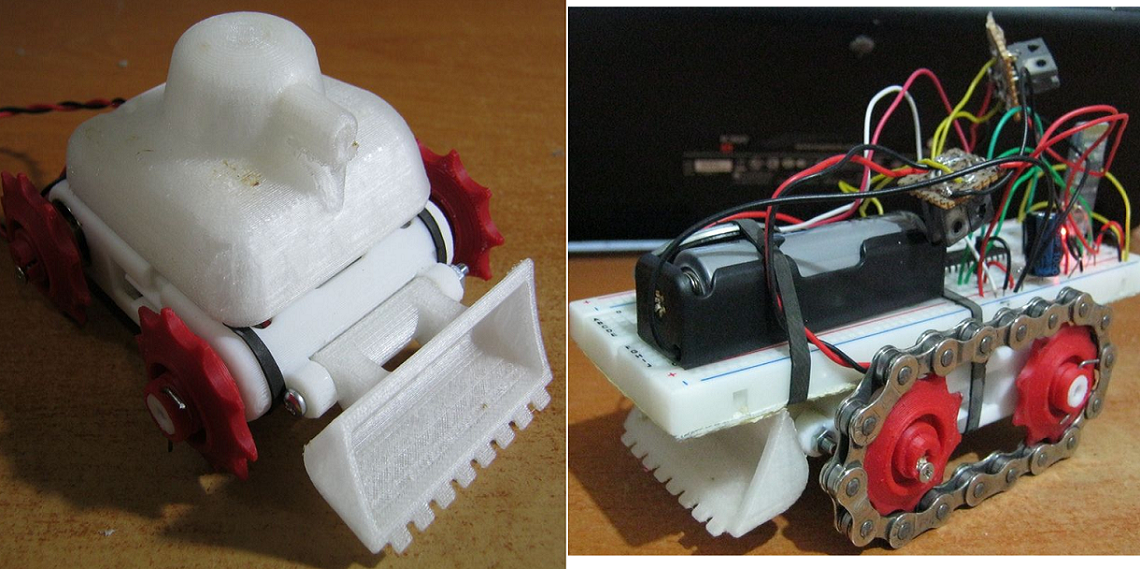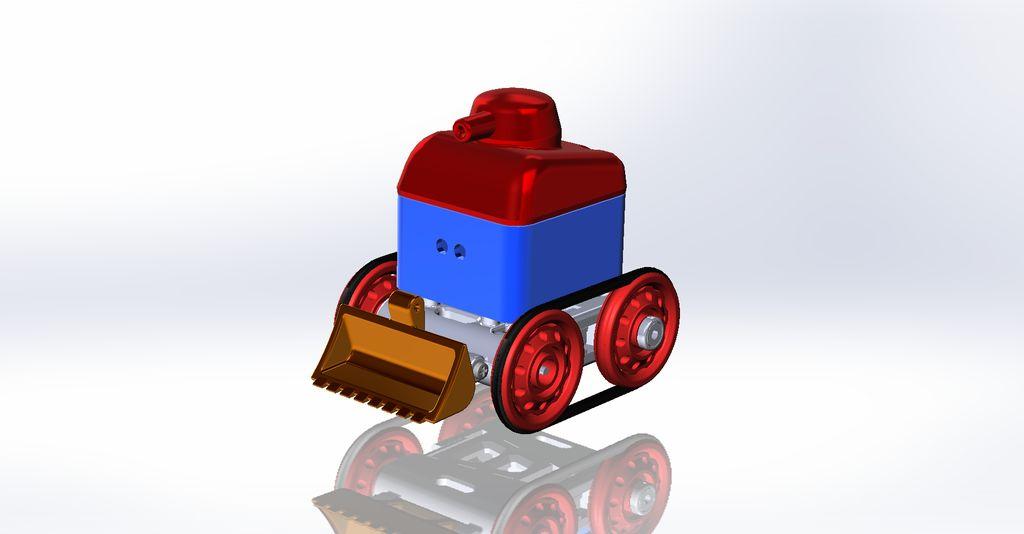The combination of 3D printing and electronics often leads to technological marvels on all levels, and certainly allows today’s makers a wide range of latitude — along with functionality and straight-up amusement — when creating projects.
A mini-marvel in itself, the ‘Multi-Purpose Talking Robot,’ created by a hobbyist from Istanbul, can function as a great project for anyone, especially a parent/child team. The design is modular so that you can let the toy take whatever form works best for your uses, whether you want a talking robot that checks the weather outside and reports back to you, or just a basic toy. Depending on use or mood, you can pick your challenge level–or add on later.
The world of toys—and creating them–became much broader and more accessible with the advent of 3D printing. With the flexibility and independence offered by digital design and 3D printing, tinkerers and designers can suddenly offer amazing projects to the world, without having to possess enormous amounts of capital to enter the somewhat formidable traditional toy industry.
In an Instructable from Istanbul’s Dr. Özkal Özsoy (aka hobbyman), we take a look at a project that allows you to choose which level of complexity you want to shoot for. Özsoy, a full-time professor in the industrial design department at a fine arts university, has been 3D printing with his UP! 3D printer for four years now (including a dummy security camera). Aside from his professorial duties, he is also an electrical engineer and product design consultant, as well as an inventor who has interest in—no surprise—the toy sector.
Özsoy has obviously put many of his talents and background experience to work in this particular robotics project, imbuing it with the potential to create quite a complex robotic contraption, which you’ll see from the attached video, which shows the fully built multi-purpose robot navigating a path while speaking in its programmed ‘Warcraft’ voice.
The 3D printed robotics combination, controlled by PC through Bluetooth link, can work as a:
- Classic robot
- Bulldozer
- Tank
- Digger toy
- More advanced robotic platform
You have options in this robotics project, regarding the platform, as it can be made to work as a robot by installing motors inside the platform, or, just as cool–Özsoy supplies axle parts for 3D printing which can be used to transform the platform into a simple but durable push toy. With the modular design, you can go as simple or elaborate as you want. For the platform you can add:
- A front bulldozer bucket
- A tank turret
- Module for expanding storage area for items such as the batteries, sensors, electronics
- Extension levels, which operate like shelves
- Digger mechanism
There are options in the area of wheels also. How complex do you want to go? If you just want ordinary wheels functioning with O-rings, that works—as well as emulating Özsoy’s creative use of a bike chain (he used an old one from his own bike) that can be cut and used like ‘a caterpillar track.’ For the four-part chassis, there are several considerations, depending on whether you are going simple or advanced. Chassis, wheels, and all related accessories are available for download at Thingiverse by Özsoy.
“The most important thing about the chassis may be the mechanism at the center consisting of two conical shaped parts that enables the user to tighten the chain by lengthening and shortening the entire chassis by turning a single screw,” said Özsoy.
 The digger is a cool gizmo to add to your robot platform should you choose, and is also made available on Thingiverse by Özsoy, who points out that while it’s a great addition for kids, it can also really add to the complexity of the project with the addition of motors and remote control.
The digger is a cool gizmo to add to your robot platform should you choose, and is also made available on Thingiverse by Özsoy, who points out that while it’s a great addition for kids, it can also really add to the complexity of the project with the addition of motors and remote control.
As Özsoy, not surprisingly, chooses to make the more complex option of the robot platform, he uses his UP! 3D printer to print the wheels, turret, and bucket. After printing, the pieces are assembled with some soldering being required in connecting the power wires to the motors which must also be connected together, along with the battery.
For electronics, Özsoy (let’s remember he is an electrical engineer, ahem!) attempted to remain as simple as possible.
“I’ve made a simple circuit on proteus, with a PIC 18F2525 controller due to its ROM size,” states Özsoy. “I needed a bigger ROM size because I wanted this robot to talk. I’ve used Warcraft voice samples which I’ve downloaded from the net.”
“The code uses a one-pin DAC algorithm to reproduce the converted sound samples by using a single digital output pin. Sound samples’ data is embedded into the code. There is a simple RC filter to improve the cracking sound produced by the 1 pin digital output. A small amplifier can even enhance the output also amplifying it.”
Also required are:
- Two H bridges for the DC motors
- Temperature sensor (for use with temperature robot)
The remote control works through the ‘Blue Sticks’ control app, available on Android.
“The Bluestick control program sends numeric keypad data when the arrows are pressed, so I’ve arranged my code to accept them,” states Özsoy. “And you can simply use the numeric keypad on the PC to control it through a real-term program.”
Here is an example of what you can expect:
- w – “We move.”
- y – “Yes, my lord.”
- r – “Ready to serve, my lord.”
With numerics keyed in, the robot goes forward, back, left, and, right, and will also announce his directions. Note that if you key in the wrong number or letter, he will simply say, “Sorry.”
With the complex version, you are rewarded with a robot that talks to you and ‘obeys’ your orders through Bluetooth. With many other options and customizable source codes available online, this is obviously a modular concept that you can improve on and take up—or down—a notch, depending on your level of expertise.
Is this a robot you are interested in 3D printing and building out? What level of difficulty are you planning to shoot for with this design—and is it for you or a child? Share with us in the Modular 3D Printed Robot forum thread over at 3DPB.com.
Subscribe to Our Email Newsletter
Stay up-to-date on all the latest news from the 3D printing industry and receive information and offers from third party vendors.
Print Services
Upload your 3D Models and get them printed quickly and efficiently.
You May Also Like
The Market and Industry Potential of Multi-Material 3D and 4D Printing in Additive Electronics
Additive manufacturing leverages computer-based software to create components for products by depositing either dielectric or conductive materials, layer by layer, into different geometric shapes. Since its birth in the 1980s,...
3DPOD 262: Bio-inspired Design for AM with Dhruv Bhate, Arizona State University
Dhruv Bhate is an associate professor at Arizona State University. There, he looks at structures, materials, and design. Previously, he worked at PADT as well as in the semiconductor and...
3DPOD 261: Tooling and Cooling for AM with Jason Murphy, NXC MFG
Jason Murphy´s NXC MFG (Next Chapter Manufacturing) is not a generalist service; instead, the company specializes in making tooling. Using LPBF and binder jet, the company produces some of the...
3DPOD 260: John Hart on VulcanForms, MIT, Desktop Metal and More
John Hart is a Professor at MIT; he´s also the director of the Laboratory for Manufacturing and Productivity as well as the director of the Center for Advanced Production Technologies....




































